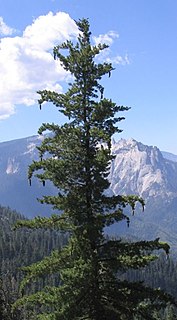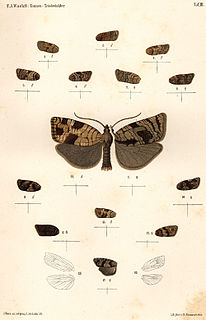
Choristoneura is a genus of moths in the family Tortricidae. Several species are serious pests of conifers, such as spruce and are known as spruce budworms.

Pinus lambertiana is the tallest and most massive pine tree, and has the longest cones of any conifer. The species name lambertiana was given by the British botanist David Douglas, who named the tree in honour of the English botanist, Aylmer Bourke Lambert. It is native to coastal and inland mountain areas along the Pacific coast of North America, as far north as Oregon and as far south as Baja California in Mexico.

Pinus ponderosa, commonly known as the ponderosa pine, bull pine, blackjack pine, western yellow-pine, or filipinus pine is a very large pine tree species of variable habitat native to mountainous regions of western North America. It is the most widely distributed pine species in North America.

The Tortricidae are a family of moths, commonly known as tortrix moths or leafroller moths, in the order Lepidoptera. This large family has over 11,000 species described, and is the sole member of the superfamily Tortricoidea, although the genus Heliocosma is sometimes placed within this superfamily. Many of these are economically important pests. Olethreutidae is a junior synonym. The typical resting posture is with the wings folded back, producing a rather rounded profile.

Choristoneura fumiferana, the eastern spruce budworm, is a species of moth of the family Tortricidae native to the eastern United States and Canada. The caterpillars feed on the needles of spruce and fir trees. Eastern spruce budworm populations can experience significant oscillations, with large outbreaks sometimes resulting in wide scale tree mortality. The first recorded outbreaks of the spruce budworm in the United States occurred in about 1807, and since 1909 there have been waves of budworm outbreaks throughout the eastern United States and Canada. In Canada, the major outbreaks occurred in periods circa 1910–20, c. 1940–50, and c. 1970–80, each of which impacted millions of hectares of forest. Longer-term tree-ring studies suggest that spruce budworm outbreaks have been recurring approximately every three decades since the 16th century, and paleoecological studies suggest the spruce budworm has been breaking out in eastern North America for thousands of years.

Choristoneura occidentalis is a species of moth of the family Tortricidae. It is found in the Democratic Republic of Congo, South Africa, Tanzania and Gambia.

Celypha striana is a moth of the family Tortricidae. It is the type species of its genus Celypha.

Choristoneura murinana is a moth of the family Tortricidae. It is found in central Europe and the Near East, China, Taiwan and in North America.

Choristoneura rosaceana, the oblique banded leaf roller or rosaceous leaf roller, is a moth of the family Tortricidae. It is native to North America, but has been accidentally introduced into other parts of the world.

Choristoneura pinus, the jack pine budworm, is a moth of the family Tortricidae. The species was first described by Thomas Nesbitt Freeman in 1953. It is found in jack pine forests in Canada from Atlantic provinces to Cypress Hills on the Alberta-Saskatchewan border as well as northern United States from New England to the lake states.

Acleris is a genus of moths belonging to the subfamily Tortricinae of the family Tortricidae. As of 2007, about 241 species were known.
Epinotia rubiginosana is a moth of the family Tortricidae. It is found from Europe to eastern Russia, China, Korea and Japan.

Rhyacionia duplana, the summer shoot moth or Elgin shoot moth when referring to subspecies logaea, is a moth of the family Tortricidae. It is found from northern and central Europe to eastern Russia, China and Japan. It has also been reported from Korea, but it has not been found in recent studies.
Zeiraphera rufimitrana, the red-headed fir tortricid, is a moth of the family Tortricidae. It is found from central Europe to eastern Russia, Mongolia, the Korean Peninsula, China and Japan. It was first recorded from the Netherlands by Kuchlein and Naves in 1999.

Pandemis corylana, the chequered fruit-tree tortrix, hazel tortrix moth, filbert tortricid or barred fruit tree moth, is a moth of the family Tortricidae. It is found from northern and central Europe to Siberia, Korea and Japan.
Argyrotaenia montezumae is a species of moth of the family Tortricidae. It is found in Guatemala, Mexico and the United States, where it has been recorded from Arizona and New Mexico.
Argyrotaenia kimballi, Kimball's leafroller moth, is a species of moth of the family Tortricidae. It is found in the United States, where it has been recorded from Alabama, Florida, Louisiana, Maryland, Mississippi, North Carolina, South Carolina, Tennessee and Texas.

Choristoneura obsoletana is a species of moth of the family Tortricidae. It is found in the United States, where it has been recorded from Alabama, Arkansas, California, Florida, Illinois, Kansas, Louisiana, Maine, Massachusetts, Mississippi, Missouri, New Mexico, North Carolina, Ohio, Oklahoma, Oregon, South Carolina, Tennessee, Virginia and West Virginia.
Choristoneura ferrugininotata is a species of moth of the family Tortricidae. It is found in the north-western Himalayas in India.
Nicholas Sergeevich Obraztsov (1906–1966) was a Russian-American scholar, entomologist, and leading specialist of the tortricoid microlepidoptera.

















